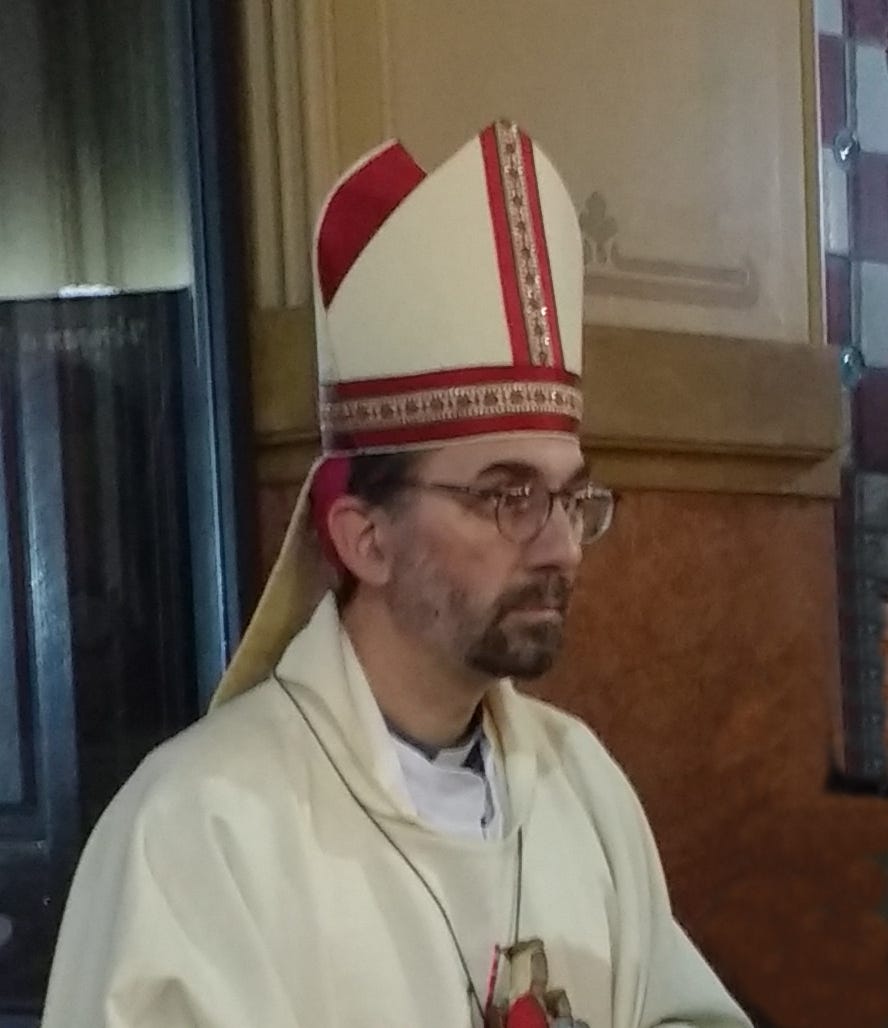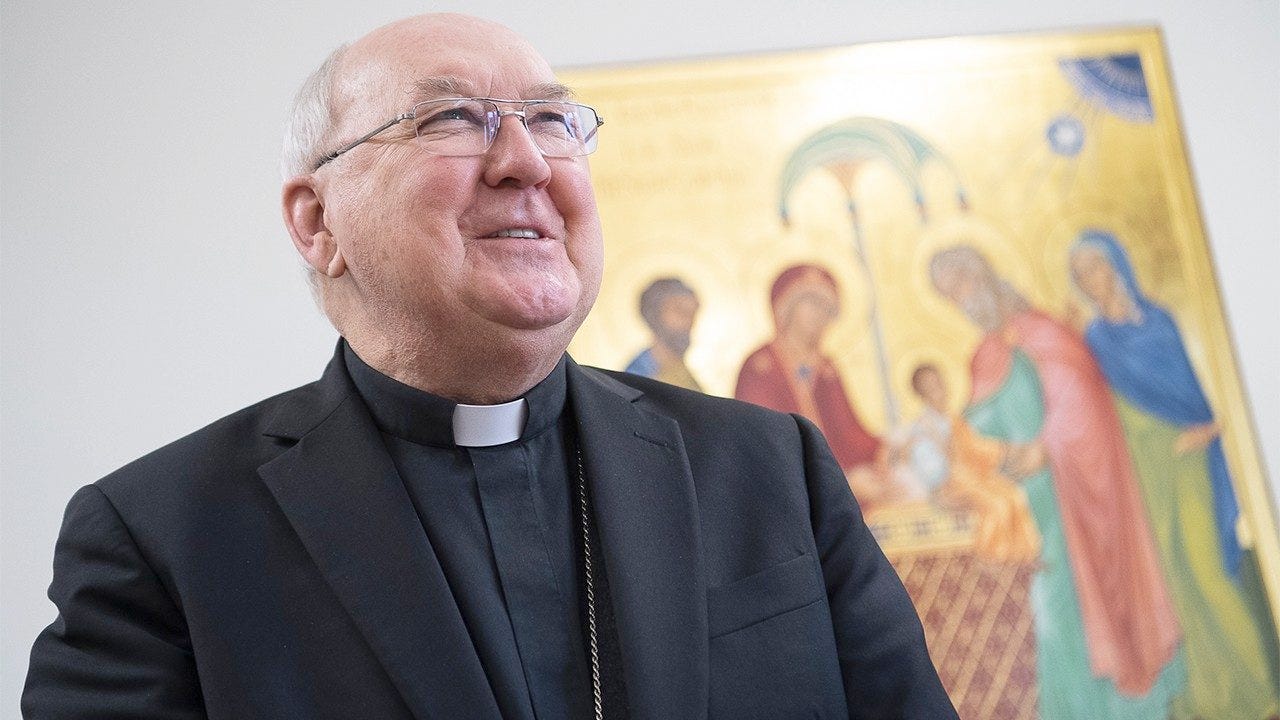Noreen Madden McInnes is a wife, mother, and grandmother. Since 2014, she has served as the Director of Liturgy and Spirituality for the Diocese of San Diego. And her new book, “Keep at it, Riley!” is about the transformative experience of caring for her elderly father in his final months.
McInnes talked with The Pillar’s Charlie Camosy about dying with hope, finding Christ in the sick, and the spiritual needs of people preparing for death.
This interview has been edited for length and clarity.
Full disclosure: Your new book is the second in a new series I'm editing for New City Press, we’re calling The Magenta Series.
Some will be explicitly about resisting the red/blue, right/left toxic binary, while others will help build up a foundational vision of the good, and especially of human dignity, that can undergird resistance to that kind of polarization.
Your book falls into the latter category, I think. What's the vision of human dignity you’re trying to get across?
“Keep at it, Riley!” tells the story about how Catholic faith accompanied my family through the sickness and death of my elderly parents. Dying with dignity means being called home to God with your loved ones gathered around you, not assisted suicide, as some have tragically and mistakenly renamed it.
My parents, like many elderly people, were afraid to be a burden on their children when they were sick. No one wants that. No one chooses to suffer.
Oh wait, didn’t Jesus?
If we can accept that when we are sick, suffering, and dependent upon others for our care, we can turn to Jesus as our model, our source of strength and dignity. We can find glory in our cross as Jesus did, offering it up for the salvation of others. We can use our time up until our last breath as an opportunity to bring others to our Lord.
Many of us recognize that the generations coming behind us don’t have the strong faith that we are blessed with. Let us not waste the opportunity to witness our faith in the resurrection, that in death our life does not end, only changes.
“For God so loved the world that he gave his only Son, so that everyone who believes in him might not perish but might have eternal life” (Jn 3:16) — Let your children have the opportunity to see that aging and illness, often mistakenly described as a downward spiral, through the lens of God, is instead, moving graciously upwards. As we are called home to God let those around us catch a glimpse of heaven.
With the help of God, your children will discover that ministering to the sick, though challenging, is not a burden. It is a tremendous blessing and a profound witness to the teaching of St. Francis, that in giving, we receive.
“Keep at it, Riley!” is an interesting and maybe even unusual title for a book about someone who is near the end of their life on earth. Can you talk a bit about what this title means and why you choose it?
When my father was a small boy, my grandfather would often goad him with the words, “Keep at it, Riley!” It irritated my dad — his name was Frank — because it demanded that he never give up or give in, even if he desperately wanted to at times.
But this annoying phrase, disguised as a curse, became his blessing. It developed into a mantra that helped him persist through the many challenges he faced throughout his life. It became my dad’s way to let go, let God. He learned to trust in God’s accompaniment — God doesn’t promise that we have no burdens or trials, but he does promise that he will not abandon us.
This worked well for my dad with problems big and small, and even in those situations that seemed insurmountable.
When my dad was 82, very ill and in the hospital, my mother tragically died in a car accident. Left without his caregiver, advocate, and bride of sixty years, my father agreed, against medical advice, to travel from Pennsylvania to California to live with me and my family.
A big man, 6’6”, couldn’t walk, and required regular medical attention, didn’t have many travel options. After riding in a medical RV, 48 hours straight, he arrived safely at our door. We were so blessed to have him live with us for six amazing months. He certainly kept at it, Riley!
I sifted through family history in search of clues for the source of “Keep at it, Riley!” but was unsuccessful. I never found a Riley or ancestors that said that phrase, but I was able to confirm that they lived by it.
Our Maddens suffered through the Great Famine in Ireland and emigrated to America on board what was known as a coffin ship because of the high percentages of passengers that died along the way. Arriving in Pennsylvania, they risked their lives working in coal mines to earn an honest wage. Due to the oppression they had lived under for generations, they were illiterate, and did not have skills for other work.
They clung to their faith.
They put on the breastplate of St. Patrick and never gave up.
Some might say that the subtitle of the book — “Accompanying my father from death into life” —seems to have that backwards. Doesn't “life into death” make more sense?
My father, with his “Keep at it, Riley!” motto had designated in his advanced directive that he was “full code” which meant he wanted all life-prolonging procedures to be used as necessary, including CPR, a ventilator, and kidney dialysis.
He was not ready to die. He wanted to live.
Watching him fight to maintain his health was heartbreaking, though. I could see that God was calling him home. Yet, I gave him the dignity that he deserved, as his advocate, I promised to ensure that his wishes for treatment were met, even though I would have made different choices.
But it wasn’t my call, it was entirely my dad’s.
Selfishly, I would have preferred that dad remain in our home with comfort care and die peacefully without what could be violent medical interventions to prolong his life.
What would be the outcome if he was resuscitated? Would that be painful for him? Would he really want to spend the remainder of his days on a ventilator?
But the day came when dad was physically struggling in the hospital and could no longer keep up the fight. He said to me, “I want to go home. Take me home.”
My father was ready to let go, let God in the most profound way. The man that had “Kept at it, Riley,” was now planning his trip home. It was a sign, not of weakness, but of strength. He was ready to go home.
Frank spoke loudly, clearly, and emphatically as if he wanted to be sure I would remember that he was the one that had said it. This was his decision. There was to be no burden on me or my sisters. It was clear that he wanted to go home! My big, strong, fighting Irish daddy was ready to go home to God. He was no longer fighting death; he was ready to pass to eternal life.
But in a more profound way, my father accompanied me from death into life. He opened my eyes and my heart to see the blessing of accompanying someone as they are called home to God, to be in a thin place.
In the mystical realm of Celtic spirituality, “Thin Places” are where one can catch a glimpse of the divine, where only a thin veil separates heaven and earth. Where one can easily pass from one side to the other. It was a tremendous gift to be alongside my dad as he passed to the other side, from death into life.
You are a student of liturgical theology and the director of liturgy and spirituality for the Diocese of San Diego. How was liturgy part of your father’s “whole person care”?
Our aging, sick, and dying need more than medical knowledge and legal expertise; they and their loved ones are often thirsting for spiritual care.
Ministry to the sick is an extension of the mission of Jesus who cared for the whole person, body and soul, as he “went around to all the towns and villages, teaching in their synagogues, proclaiming the gospel of the kingdom, and curing every disease and illness” (Mt 9:35).
Today the Catholic Church continues to bring the healing touch of Christ to the infirm and the marginalized through the sacraments for Pastoral Care of the Sick: Communion of the Sick, Anointing of the Sick, and Viaticum. In bringing the sacraments to the sick we are Jairus who invited Jesus into his home to heal his dying daughter (Mk 5:23). We are the men lowering the paralytic through the roof of the house to Jesus (Lk 5:17-26). We accompany our loved ones as they reach out and touch the hem of Jesus’ garment (Mk 5:25-29).
And when we are called home to God, the celebration of the Order of Christian Funerals comforts those mourning with hope in the resurrection and in thanksgiving for the gift of a life now returned to God.
I think maybe some people are intimidated about the prospect of welcoming their parents into their own during their last months and weeks.
Do you think your book could help someone get more comfortable with this idea?
It was a mistake. I should not have been the one that was called to help my aging parents as their lives slowly unraveled. They needed someone with medical knowledge to help them address their numerous and complex health issues; my younger sister, Ellyn, the nurse, would have been the obvious choice. They needed someone with legal expertise to organize their estate; my older sister, Mari, the lawyer, would have been perfect. They also needed a cook and a housekeeper; pretty much anyone else on the planet would have been a better choice for that than me.
Why was I called? I am just a choir director, a liturgist, and a student of theology, I didn’t have any of the necessary skills to reach out to my parents at this time of their lives.
Or did I?
Honestly, not only did I lack medical training, but I had always been quite squeamish around illness. But caring for my dad in my home, I truly had the grace of God to overcome it. With the help of God, I was able to focus on him and his needs and put aside my doubts and fears.
Was it a sacrifice for him? I didn’t really see it that way.
What is more important than caring for a loved one in their time of need? Taking on St. Teresa of Calcutta’s vision and prayer, we can rise above what we are lacking. “I see Jesus in every human being. I say to myself; this is hungry Jesus; I must feed him. This is sick Jesus. This one has leprosy or gangrene; I must wash him and tend to him. I serve because I love Jesus.” (St. Teresa of Calcutta).
The care for my father blessed me more than I blessed him.



